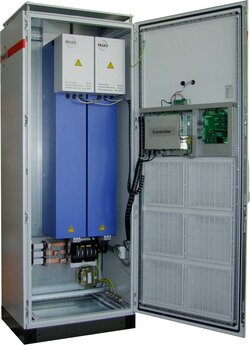Active filters combat disruptive harmonics
If an automated production process or business operation grinds to a halt for no apparent reason, refrigeration systems trip out or the radio hums at a low frequency, harmonics in the electrical installation are very often to blame. These are frequently caused by electronically controlled equipment with nonlinear characteristics, for example dimmers, chopper-type power supply units or frequency converters. A detailed analysis of the network can quickly shed light on the issue and reveal the causes. Unscheduled interruptions of normal operation are not just a nuisance; they engender additional costs, cause loss of production or can even damage equipment and installations, possibly leading to dangerous situations. If the harmonics are generated within a company's own infrastructure, it has sole responsibility for eliminating them through active or passive filters. The power supply company is not liable for this problem.
Initial status
The main cause of the rising levels of harmonics pollution is the constantly increasing number of nonlinear loads in the supply network. Firstly, electrical equipment is becoming ever more sensitive to disturbances, but secondly, modern devices themselves contribute to the problem because of their continual sharp-edged switching operations—the price we pay for our modern high-tech world and its optimization of energy consumption. Even if individual devices comply with the current criteria of EN 50160, a certain number of them in a network can result in serious levels of harmonics. The processes involved are highly complex and dependent on many local conditions, hence they can hardly be predicted purely by theoretical calculation. A situation where such pollution is present can therefore only be analysed by making on-site measurements.
Dynamic processes need active filters
To eradicate harmonics, devices are installed that ‘filter them out’, then feed them back into the power line again but with a 180° phase shift, thus reducing the distortion of the supply voltage. As a rule, these active filters are fitted close to the transformer or to major power consumers. They are dimensioned to handle the largest possible loading of the installation. If the system is very widely dispersed, it is practical to decentralize the filters. This way the feed lines can also be included, and if a simultaneity factor is taken into account, the filters can be dimensioned only for specific sections of the installation, since not all the equipment is ever in operation at the same time. Passive filters are used for continuously operating systems, whereas active filters are installed in dynamic processes. This applies to almost all sectors, from public swimming pools to industrial plants. Even just switching ventilation and air conditioning systems on and off to meet demand, continual start-stop operations or the soft starters of industrial drives cause massive network perturbations. Active filters are self-regulating and adapt continuously to changing network conditions. They are therefore an excellent choice for dynamic processes.
A flexible duo: active filter with service package
FRAKO offers highly dynamic active filters with its OSFS series, available as wall-mounted or freestanding units. Their modular design allows them to be extended and optimized to meet the need for additional compensation. A wide range of power ratings is covered, with compensating currents from 60 A upwards.
The units can be installed side by side in one cabinet and connected in parallel to provide up to 300 A. Several such cabinets can also be linked in parallel for higher currents. The active filters offer web server functionality, so they can automatically transmit messages, and if desired can be monitored remotely. It is up to users to decide which of these possibilities they want to make use of themselves, and which should be entrusted to FRAKO and its SupervisionService.
Refrigeration systems running reliably again
In the Europa-Park in Rust in south-west Germany, each of the 15 individual themed area with its amusement rides and restaurants has its own transformer station. For over 15 years these have been monitored by FRAKO network analysis instruments, which transmit their data to the site utilities technical office. This way the operator has a detailed
overview of the transformer loading at all times, and has the flexibility to manage short-term power demands. In the Austria themed area, the ‘Alpenexpress Enzian’ is a train ride with 10 passenger cars that runs up hill and down dale around a track, one circuit taking about two minutes. For the main drive, this involves a highly dynamic process, with a sequence of widely varying demand cycles: starting, accelerating, braking and standing still. Every time the train ran, the refrigerators in a restaurant and some electronic equipment stopped working. As this could be clearly demonstrated right from the start, it was only necessary to measure the harmonics content and waveform distortion in order to dimension the required active filter correctly. In this case the harmonics content in the power supply was some two to two-and-a-half percent with the train stationary, but it shot up to over eight percent when the train was running.
The operator installed the filter directly at the ride. “We didn't want to take any chances, so we tackled the cause of the problem at its source”, states Markus Spoth, the manager responsible for the electrical installations at Germany's largest theme park, “Operation is now completely free from disturbances, and there is no interference at all with neighbouring power consumers.” In addition, this measure reduced the loading of the transformer, which will have a beneficial effect on its service life. A FRAKO OSFS 130 active filter was installed, a wall-mounted unit with the dimensions H x W x D of 204 x 23 x 47 cm.
September 2017




